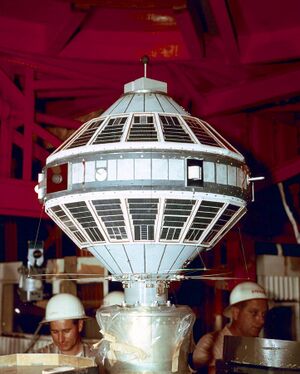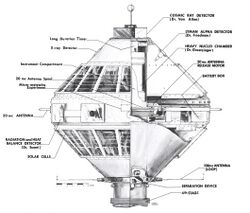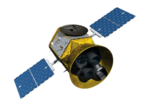Astronomy:Explorer 7
 | |
| Mission type | Earth science |
|---|---|
| Operator | NASA |
| Harvard designation | 1959 Iota 1 |
| SATCAT no. | 22 |
| Mission duration | 2 years |
| Spacecraft properties | |
| Manufacturer | Jet Propulsion Laboratory |
| Launch mass | 41.5 kilograms (91 lb) |
| Start of mission | |
| Launch date | October 13, 1959, 15:30:04 UTC[1] |
| Rocket | Juno II |
| Launch site | Cape Canaveral Air Force Station Cape Canaveral Air Force Station Launch Complex 5 |
| End of mission | |
| Last contact | August 24, 1961 |
| Orbital parameters | |
| Reference system | Geocentric |
| Regime | Low Earth |
| Semi-major axis | 6,982.76 kilometers (4,338.89 mi) |
| Eccentricity | 0.015834 |
| Perigee altitude | 501 kilometers (311 mi) |
| Apogee altitude | 722 kilometers (449 mi) |
| Inclination | 50.28 degrees |
| Period | 96.78 minutes |
| RAAN | 48.57 degrees |
| Argument of perigee | 215.06 degrees |
| Mean anomaly | 186.76 degrees |
| Mean motion | 14.87 |
| Epoch | 17 December 2013, 05:12:52 UTC[2] |
| Revolution no. | 87,055 |
Explorer program | |
Explorer 7 was launched October 13, 1959 at 10:36 a.m. Eastern Time by a Juno II rocket from Cape Canaveral Air Force Station to an orbit of 573 km by 1073 km and inclination of 50.27°.[3] It was designed to measure solar x-ray and Lyman-alpha flux, trapped energetic particles, and heavy primary cosmic rays. Secondary objectives included collecting data on micrometeoroid penetration, molecular sputtering and studying the Earth-atmosphere heat balance.
Launch was originally scheduled for late September 1959, but the mission was delayed for a week after a Jupiter IRBM test on an adjacent pad failed shortly after liftoff, causing flying debris to hit Explorer 7's launch vehicle. However, the damage to the booster was minor and could be easily repaired.
Significantly, it also carried Verner Suomi's flat-plate radiometer, improved with the help of Robert Parent, that took the first Earth radiation budget measurements from space and initiated the era of satellite studies of the climate. Using both satellite observations of the Earth's heat balance and atmospheric cooling rates measured by net flux radiosondes, Suomi established the important role played by clouds in absorbing radiated solar energy. These observations established that Earth's energy budget varies markedly due to the effect of clouds, the surface albedo, and other absorbing constituents. Using these instruments, Suomi and his team discovered that the Earth absorbed more of the Sun's energy than originally thought and demonstrated that it was possible to measure and quantify seasonal changes in the global heat budget. Explorer 7 was unable to detect solar x-rays due to its sensors being saturated by background radiation in the Van Allen Belts.[4]
The satellite weighed 41.5 kg, was 75 cm high and 75 cm wide. Powered by solar cells, it also carried 15 nickel-cadmium batteries around its equator.
It transmitted data continuously through to February 1961 and went dead on August 24, 1961. It is still in orbit.[5]
References
- ↑ McDowell, Jonathan. "Launch Log". Jonathan's Space Page. http://planet4589.org/space/log/launchlog.txt. Retrieved 17 December 2013.
- ↑ "EXPLORER 7 Satellite details 1959-009A NORAD 22". N2YO. December 17, 2013. http://www.n2yo.com/satellite/?s=22. Retrieved December 17, 2013.
- ↑ "50th Anniversary of Explorer 7 Launch". Space and Science Engineering Center. University of Wisconsin. http://www.ssec.wisc.edu/media/spotlight/explorer7.html. Retrieved 13 February 2010.
- ↑ Significant Achievements in Solar Physics 1958-1964. Washington D.C.: NASA. 1966. p. 63.
- ↑ "U.S. Space Objects Registry". Archived from the original on October 30, 2007. https://web.archive.org/web/20071030213556/http://usspaceobjectsregistry.state.gov/registry/index.cfm?fuseaction=home. Retrieved 2011-11-29.



